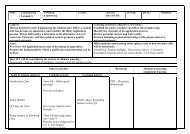Crocodile Clips
Crocodile Clips
Crocodile Clips
Create successful ePaper yourself
Turn your PDF publications into a flip-book with our unique Google optimized e-Paper software.
e-learning inElectronics
The Design Process• Lesson 1: Circuit Simulations• <strong>Crocodile</strong> clips• Lesson 2: Design Decisions• Modular circuit design• Lesson 3: Realising my Design• <strong>Crocodile</strong> clips + modular circuit design• Lesson 4: Building the Prototype• Breadboarding• Lesson 5: Manufacture• PCB design / Automatic manufacture
Lesson 1Circuit Simulations<strong>Crocodile</strong> clips
• AimObjectives• Develop a students electronics design skills though e-learning.e• Develop confidence and knowledge in the use of crocodileclips.• Objectives• Construct simple circuits using crocodile clips.• Make informed decisions over the choice of switches used inelectronics circuits through practical experience of their operation.• Incorporate logic gates as a means of controlling decisions withininbasic circuits.• Discover ways of monitoring circuit action using probes, on screenenmessages and graphical images.• Investigate the action of Astable and Monostable clocks using theprepared circuits in the package.
1. Navigation and Tutorial• HTML link to crocodileclipsCrocphys.exe
The <strong>Crocodile</strong> Tutorial• The 2 tutorials under Help provides aneffective route for investigating theinitial workings of crocodile physics.• Activity 1• Follow the Electronics tutorial. This willprovide you with the initial skillsrequired to investigate this package.
2. Switching• In order to provide a clean transitionfrom 0 to 1 in TTL logic circuitsswitches should be pulled cleanlybetween 0V and 5V. This is done usinga pull down resistor R of 470Ω• Activity 2 – Using JU1_switchesSet the circuit with a logic monitor onthe output, then investigate the action.Extension:The circuit you have made iscommonly known as a Pull Up switch.Try designing a pull down switch.Sketch solution opposite:-
4. Output Displays – The LED array• An LED normally needs a forwardvoltage drop of 2V and sufficient lightis emitted with 10mA. A resistor isusually added to protect the LED fromdamage.• Activity 4: Find the value of theresistor needed to control the currentat 10mA when the supply voltage is5V. (Use JU1_LED)Extension:• Add an Ammeter in series with theLED, Resistor and find the safe currentwhich turns on the LED.• Fill in Answer here =• Now retry this with a voltage of 9V asshown opposite. What protectiveresistor is needed in this case?
JU1_switches_NOTJU1_And_gatesJU1_LEDs
5. Monostable v Astable ClocksMonostable.• A trigger pulse produces asingle pulse of fixed duration.Astable• This is a free running andproduces a continuous supply ofpulses at the output.
Creating my First ClockActivity 5: Using the models – Examples – Electronics Examples – Oscillator 1provided investigate the settings required to produce an Astable clock with afrequency of 1Hz or period of 1s. You will need to alter the resistor thatstarts as 22k. Use the pulse in the graph to monitor the output frequency.
















